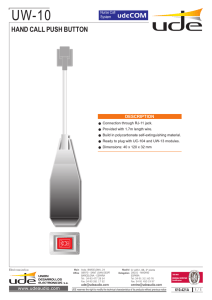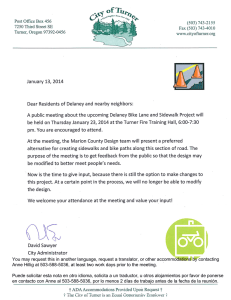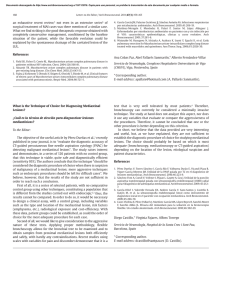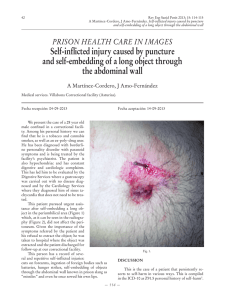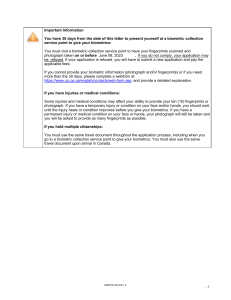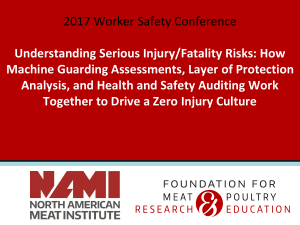Definitions of hospital discharge, severe injury and death
Anuncio
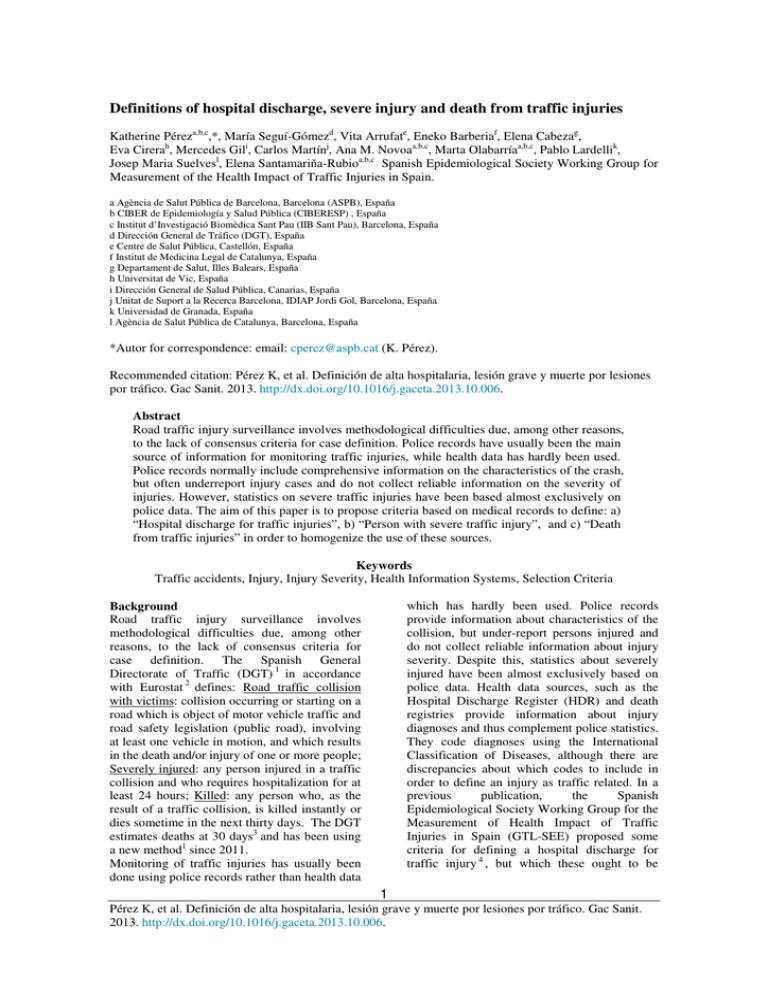
Definitions of hospital discharge, severe injury and death from traffic injuries Katherine Péreza,b,c,*, María Seguí-Gómezd, Vita Arrufate, Eneko Barberiaf, Elena Cabezag, Eva Cirerah, Mercedes Gili, Carlos Martínj, Ana M. Novoaa,b,c, Marta Olabarríaa,b,c, Pablo Lardellik, Josep Maria Suelvesl, Elena Santamariña-Rubioa,b,c Spanish Epidemiological Society Working Group for Measurement of the Health Impact of Traffic Injuries in Spain. a Agència de Salut Pública de Barcelona, Barcelona (ASPB), España b CIBER de Epidemiología y Salud Pública (CIBERESP) , España c Institut d’Investigació Biomèdica Sant Pau (IIB Sant Pau), Barcelona, España d Dirección General de Tráfico (DGT), España e Centre de Salut Pública, Castellón, España f Institut de Medicina Legal de Catalunya, España g Departament de Salut, Illes Balears, España h Universitat de Vic, España i Dirección General de Salud Pública, Canarias, España j Unitat de Suport a la Recerca Barcelona, IDIAP Jordi Gol, Barcelona, España k Universidad de Granada, España l Agència de Salut Pública de Catalunya, Barcelona, España *Autor for correspondence: email: cperez@aspb.cat (K. Pérez). Recommended citation: Pérez K, et al. Definición de alta hospitalaria, lesión grave y muerte por lesiones por tráfico. Gac Sanit. 2013. http://dx.doi.org/10.1016/j.gaceta.2013.10.006. Abstract Road traffic injury surveillance involves methodological difficulties due, among other reasons, to the lack of consensus criteria for case definition. Police records have usually been the main source of information for monitoring traffic injuries, while health data has hardly been used. Police records normally include comprehensive information on the characteristics of the crash, but often underreport injury cases and do not collect reliable information on the severity of injuries. However, statistics on severe traffic injuries have been based almost exclusively on police data. The aim of this paper is to propose criteria based on medical records to define: a) “Hospital discharge for traffic injuries”, b) “Person with severe traffic injury”, and c) “Death from traffic injuries” in order to homogenize the use of these sources. Keywords Traffic accidents, Injury, Injury Severity, Health Information Systems, Selection Criteria which has hardly been used. Police records provide information about characteristics of the collision, but under-report persons injured and do not collect reliable information about injury severity. Despite this, statistics about severely injured have been almost exclusively based on police data. Health data sources, such as the Hospital Discharge Register (HDR) and death registries provide information about injury diagnoses and thus complement police statistics. They code diagnoses using the International Classification of Diseases, although there are discrepancies about which codes to include in order to define an injury as traffic related. In a previous publication, the Spanish Epidemiological Society Working Group for the Measurement of Health Impact of Traffic Injuries in Spain (GTL-SEE) proposed some criteria for defining a hospital discharge for traffic injury 4 , but which these ought to be Background Road traffic injury surveillance involves methodological difficulties due, among other reasons, to the lack of consensus criteria for case definition. The Spanish General Directorate of Traffic (DGT) 1 in accordance with Eurostat 2 defines: Road traffic collision with victims: collision occurring or starting on a road which is object of motor vehicle traffic and road safety legislation (public road), involving at least one vehicle in motion, and which results in the death and/or injury of one or more people; Severely injured: any person injured in a traffic collision and who requires hospitalization for at least 24 hours; Killed: any person who, as the result of a traffic collision, is killed instantly or dies sometime in the next thirty days. The DGT estimates deaths at 30 days3 and has been using a new method1 since 2011. Monitoring of traffic injuries has usually been done using police records rather than health data 1 Pérez K, et al. Definición de alta hospitalaria, lesión grave y muerte por lesiones por tráfico. Gac Sanit. 2013. http://dx.doi.org/10.1016/j.gaceta.2013.10.006. revised. In this methodological note, our aim is to propose criteria to define: a) “Hospital discharge for traffic injuries”, b) “Person with severe traffic injury, and c) “Death from traffic injuries”, based on medical records in order to homogenize the use of these sources. inflicted injury by crashing of motor vehicle” (E958.5) and “Injury by crashing of motor vehicle, undetermined whether accidentally or purposely inflicted” (E988.5), in which it is not clear whether they occur on public roads and hence whether they can be considered a “road traffic collision”. In any case these represent a small percentage. According to Eurostat, suicide or a suicide attempt is not accidental, but rather caused by an action to deliberately self-inflict fatal injuries2. Proposed definition criteria Due to the term “accident” having connotations of an event which is unpredictable and unavoidable, we propose to use the expressions “collision”, “road traffic injuries” or just “traffic injuries”. As the E-codes are not always well-reported in the HDR, accident compensation payment codes are also checked to see if the payer is a traffic accident insurance company. Assuming that mistakes are more likely in coding of diagnoses than in insurance payer codes, when an E-code appears which is not traffic-related, but the payer is a traffic accident insurance company, it is accepted as a case, provided the other criteria are met. Following a review of recommendations by the Centers for Disease Control5, the Pan American Health Organization 6 , the World Health Organization 7 , Spanish National Institute of Statistics, and having assessed agreement with DGT criteria, we propose the following criteria (table 1): The present proposal defines more precisely and improves the earlier GTL-SEE proposal in three aspects: previously, all cases were included in which a traumatic injury was mentioned in any diagnosis (not just the main diagnosis); injury codes N800-N959.9 were all included, i.e. late effects of injury (N905-909), and early complications of injury (N958) were not excluded; furthermore, readmissions were not excluded. A. Hospital discharge for traffic injuries With the aim of only considering new (incident) cases, scheduled hospital admissions (non urgent) and readmissions are excluded from the definition, and only cases in which traumatic injury is mentioned in the main diagnosis are included. If all cases with a diagnosis of traumatic injury (whether main or secondary) were to be included, this would produce an overestimate as victims admitted to hospital for other reasons in the future, would be counted more than once. For example, in a person with spinal cord injury, this diagnosis would always reappear in their successive hospitalizations for other causes. B. Person with severe traffic injury In 2010 IRTAD (International Traffic Safety Data and Analysis Group, Joint Transport International Forum, OECD), proposed using MAIS ≥ 3 (Maximum Abbreviated Injury Scale)9 as the criteria for “severe” injury. MAIS is the maximum value of the AIS (Abbreviated Injury Scale), which assigns a level of severity to each injury, ranging from 1 (slight) to 6 (potentially fatal)10. To implement this proposal would require using hospital discharge records to complement police sources. Recently, the European Commission has also adopted this definition, which must now be incorporated in statistics of the European CARE registry (Community Road Accident Database). Traumatic injury includes diagnoses with the following ICD9-CM codes (International Classification of Diseases-Clinical Modification, 9th revision): N800-N904, N910-N957, N959. These include fracture, dislocation, sprain, internal injury, open wound, injury to blood vessel, superficial injury, contusion, crushing, foreign body entering through body orifice, burns, and injury to nerves and spinal cord. It excludes late effects of injury (N905-N909), early complications of physical trauma (N958), poisoning (N960-979), toxic effects (N980-989) and other and unspecified external injuries (N990-999) 8 . It also includes the following external causes (E-codes): “Motor vehicle traffic accident” (E810-819) and “Pedal cycle accident” (E826), but excludes “Animal-drawn vehicle accident” (E827), “Accident involving an animal being ridden”, (E828), “Other road vehicle accident” (E829), “Suicide and self- C. Death from traffic injuries There are multiple definitions of death due to traffic injuries. According to the ICD10 (International Classification of Diseases, tenth revision), “A transport accident (V01-V99) is any accident involving a device designed 2 Pérez K, et al. Definición de alta hospitalaria, lesión grave y muerte por lesiones por tráfico. Gac Sanit. 2013. http://dx.doi.org/10.1016/j.gaceta.2013.10.006. primarily for, or being used at the time primarily for, conveying persons or goods from one place to another”. The ICD10 distinguishes between “Traffic accident” (any vehicle accident on a public road) and “Non-traffic accident” (any vehicle accident occurring entirely somewhere other than on a public road). In order to homogenize criteria we propose considering deaths from traffic injuries those occurring on public roads, as the DGT and international organizations propose, thus excluding the nontraffic deaths. (Table 1). References 1 Dirección General de Tráfico. Las principales cifras de la siniestralidad vial. España 2011. Madrid 2012. [Consultado el 19/09/2013]. Disponible en: http://www.dgt.es/was6/portal/contenidos/es/seguridad_vial/ estadistica/publicaciones/princip_cifras_siniestral/cifras_sini estralidadl013.pdf 2 Glosario de Estadísticas de Transporte. UNECE-EurostatITF (Internacional Transport Forum). Comisión Económica para Europa. 4a edición. [Consultado el 19/09/2013]. Disponible en: http://ec.europa.eu/eurostat/ramon/coded_files/transport_glo ssary_4_ed_ES.pdf 3 Pérez K, Cirera E, Borrell C, Plasencia A. [Motor vehicle crash fatalities at 30 days in Spain]. Gac Sanit. 2006;20:10815. Trends in hospital discharges for traffic injuries and in numbers of persons severely injured in Spain, 2000-2011 4 Pérez C, Cirera E y Grupo de trabajo sobre la medida del impacto en la salud de los accidentes de tráfico en España. Indicadores de morbilidad y mortalidad de lesión por accidente de tráfico. Ministerio de Sanidad y Consumo. Madrid 2007. NIPO: 351-07-045-2. [Consultado el 19/09/2013]. Disponible en: http://www.msssi.gob.es/profesionales/saludPublica/prevPro mocion/Lesiones/docs/INDICADORES.pdf Applying the above criteria, the numbers of hospital discharges for traffic injuries decreased from 41,561 in 2000 to 22,558 in 2011 (Table 2) (Source: HDR provided by the Information Service of the Spanish Ministry of Health, Social Services and Equality). Approximately one third of the annual totals of hospital discharges for traffic injuries have a MAIS ≥ 3. 5 Centers for Disease Control and Prevention. Recommended framework for presenting injury mortality data. (No. RR-14) MMWR 1997;46. [Consultado el 19/09/2013]. Disponible en: http://www.cdc.gov/mmwr/pdf/rr/rr4614.pdf Declaration of authorship KP and MSG conceived the idea. KP analysed the data and wrote the first draft. All authors have contributed to the interpretation of the data, writing of the article, and have approved publication of the final version. 6 Guía para la vigilancia epidemiológica de violencia y lesiones. PAHO. [Consultado el 19/09/2013]. Disponible en: http://www.paho.org/Spanish/HCP/HCN/VIO/guidelines.ht m 7 Classification Systems. Violence and Injury Prevention, World Health Organisation. [Consultado el 19/09/2013]. Disponible en: http://www.who.int/violence_injury_prevention/surveillance /classification/en/index.html Funding: None 8 Smith GS, Langlois JA, Buechner JS. Methodological issues in using hospital discharge data to determine the incidence of hospitalized injuries. Am J Epidemiol. 1991;134:1146-58. Acknowledgements Our thanks to María Ángeles Gogorcena Aoiz, of the Instituto de Información Sanitaria. Ministerio de Sanidad, Servicios Sociales e Igualdad, to Pilar Zori from de Dirección General de Tráfico, and to Dolores Martos and Maica Rodríguez, of the Agència de Salut Pública de Barcelona. 9 Amorós E, Brosnan M, Wegman F, et al. Reporting on Serious Road Traffic Casualties. Combining and using different data sources to improve understanding of non-fatal road traffic crashes. IRTAD. 2011. [Consultado el 19/09/2013]. Disponible en: http://internationaltransportforum.org/irtadpublic/pdf/RoadCasualties-Web.pdf. Conflicts of Interests: None 10 States J. The Abbreviated and the Comprehensive Research Injury Scales. In: STAPP Car Crash Journal. 13, Society of Automotive Engineers, Inc., New York 1969, ISSN 1532-8546, S. 282–294, LCCN 67-22372. 3 Pérez K, et al. Definición de alta hospitalaria, lesión grave y muerte por lesiones por tráfico. Gac Sanit. 2013. http://dx.doi.org/10.1016/j.gaceta.2013.10.006. Table 1. Criteria for Hospital discharge for traffic injuries, for Person with severe traffic injury, and for Death from traffic injuries. A. Hospital discharge for traffic injuries (ICD9-CM): must meet criteria 1, 2, 3 and 4: 1. Emergency admission. (Scheduled admissions are excluded) 2. No readmission. (Readmission meaning a new episode of hospitalization within 30 days for the same cause as the primary admission) 3. Code for Traumatic Injury in the main diagnosis (ICD9-CM Codes: N800-N904, N910-N957, N959). 4 . Either or both of the following criteria: 4.1. E-code for external cause according to ICD9-CM: E810-819, E826. 4.2. Accident compensation payer: “Traffic accident insurance company”. B. Person with severe traffic injury: Any person meeting the following criteria is to be considered “severely injured”: 1. Meet criteria for Hospital discharge for traffic injuries, as established in the previous section, and 2. Any of the diagnosed injuries receives a score ≥ 3 on the Maximum Abbreviated Injury Scale (MAIS)1. C. Death from traffic injuries (ICD10): Pedestrian: V01 - V06 V09 Pedal cyclist: V10 - V18 V19 Motorcycle rider: V20 - V28 V29 Occupant of three-wheeled motor vehicle: V30 - V38 V39 Car occupant: V40 - V48 V49 Occupant of pick-up truck or van: V50 - V58 V59 Occupant of heavy transport vehicle: V60 - V68 V69 Bus occupant: V70 - V78 V79 Animal-rider or occupant of animal-drawn vehicle V80 Occupant of railway train or railway vehicle: V81 Occupant of streetcar: V82 Occupant of special industrial vehicle: V83 Occupant of special agricultural vehicle: V84 Other: V85 - V86 V87 V88 Type of vehicle not specified: V89 Death from Traffic injuries Death from non-traffic transport injuries (Did not occur on public road) .1, .9 .2, .3 .0 .0, .1, .9 .4, .5, .9 .4, .5, .6, .9 .0, .1, .2, .3 .0, .1, .2, .3, .8 .4, .5, .9 .4, .5, .6, .9 .0, .1, .2, .3 .0, .1, .2, .3, .8 .5, .6, .7, .9 .4, .5, .6, , .9 .0, .1, .2, .3, .4 .0, .1, .2, .3, .8 .5, .6, .7, .9 .4, .5, .6, .9 .0, .1, .2, .3, .4 .0, .1, .2, .3, .8 .5, .6, .7, .9 .5, .6, .9 .0, .1, .2, .3, .4 .0, .1, .2, .3, .8 .5, .6, .7, .9 .4, .5, .6, .9 .0, .1, .2, .3, .4 .0, .1, .2, .3, .8 .5, .6, .7, .9 .4, .5, .6, .9 .0, .1, .2, .3, .4 .0, .1, .2, .3, - .1, .2, .3, .4, .5, .7, .9 .1 .0, .2, .3, .4, .5, .6, .7, .8, .9 .1, .9 .0, .2, .3, .4, .5, .6, .7, .8 .0, .1, .2, .3 .4, .5, .6, .7, .9 .0, .1, .2, .3 .4, .5, .6, .7, .9 .0, .1, .2, .3 .0, .1, .2, .3, .4, .5, .6, .7, .8, .9 - .4, .5, .6, .7, .9 .0, .1, .2, .3, .4, .5, .6, .7, .8, .9 .2,.3 .0, .1, .9 4 Pérez K, et al. Definición de alta hospitalaria, lesión grave y muerte por lesiones por tráfico. Gac Sanit. 2013. http://dx.doi.org/10.1016/j.gaceta.2013.10.006. Table 2. Hospital discharges for traffic injuries, by external cause E-code, accident compensation payer, and severity. HDR Spain, 2000-2011. Year 2000 2001 2002 2003 2004 2005 2006 2007 2008 2009 2010 2011 Traumatic injury, and Ecode for collision of motorized vehicle or bicycle Traumatic injury, and compensation payment by “Traffic accident insurance company" n 13,933 9,468 10,334 7,662 7,479 7,161 7,391 6,737 8,246 8,568 7,689 8,520 n 6,299 6,457 7,805 11,803 10,313 10,067 8,973 9,031 5,316 5,008 5,482 3,228 Traumatic injury, compensation payment by “Traffic accident insurance company”, and Ecode for collision of motorized vehicle or bicycle n 21,329 17,780 18,281 14,479 13,475 13,387 11,987 11,686 12,668 11,768 9,485 10,810 Total n 41,561 33,705 36,420 33,944 31,267 30,615 28,351 27,454 26,230 25,344 22,656 22,558 Hospital discharge for traffic injuries and Severity of MAIS >=3 n 14,298 12,171 13,045 12,569 11,835 11,715 10,898 10,464 9,862 9,205 8,315 8,390 MAIS: Maximum Abbreviated Injury Scale 5 Pérez K, et al. Definición de alta hospitalaria, lesión grave y muerte por lesiones por tráfico. Gac Sanit. 2013. http://dx.doi.org/10.1016/j.gaceta.2013.10.006. % 34.4 36.1 35.8 37.0 37.9 38.3 38.4 38.1 37.6 36.3 36.7 37.2

